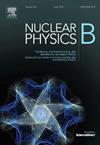强子对撞机中亲中微子暗费米子的单轻子特征
IF 2.8
3区 物理与天体物理
Q2 PHYSICS, PARTICLES & FIELDS
引用次数: 0
摘要
在高能对撞机上寻找暗物质和直接探测实验可以有效地覆盖从MeV到TeV尺度的几乎整个质量范围。本文主要研究有效场论框架下的四费米子接触相互作用。具体来说,我们对LHC的单轻子产生进行了详细的分析。我们的研究结果表明,张量算符在单轻子通道中表现出优越的灵敏度,使用当前LHC数据将几乎无质量的暗费米子的能量限制在3tev。此外,这些算子介导核靶中自旋独立和自旋依赖的吸收过程。对直接探测实验和对撞机测量之间的限制进行了系统的比较,揭示了大型强子对撞机在探索亚gev暗物质候选者方面的独特优势,同时在TeV尺度上保持了竞争性的灵敏度。值得注意的是,Super-Kamiokande和Borexino等直接探测实验通过其独特的能力:利用轻核目标、大曝光量和反冲能谱的独特特征,在10-100 MeV的质量范围内实现了互补约束。本文章由计算机程序翻译,如有差异,请以英文原文为准。
Mono-lepton signature of a neutrino-philic dark fermion at hadron colliders
Searching for dark matter at high-energy colliders and direct detection experiments can effectively cover nearly the entire mass range from the MeV to the TeV scale. In this paper, we focus on four-fermion contact interactions formulated within the framework of Effective Field Theory. Specifically, we present a detailed analysis of mono-lepton production at the LHC. Our results demonstrate that tensor operators exhibit superior sensitivity in the mono-lepton channel, constraining energy scales up to 3 TeV for a nearly massless dark fermion using current LHC data. Moreover, these operators mediate both spin-independent and spin-dependent absorption processes in nuclear targets. A systematic comparison of constraints between direct detection experiments and collider measurements reveals the LHC's distinct advantage in exploring sub-GeV dark matter candidates while maintaining competitive sensitivity at the TeV scale. Notably, direct detection experiments such as Super-Kamiokande and Borexino achieve complementary constraints in the 10-100 MeV mass range through their unique capabilities: utilization of light nuclei targets, large exposure volumes, and distinctive features of the recoil energy spectra.
求助全文
通过发布文献求助,成功后即可免费获取论文全文。
去求助
来源期刊

Nuclear Physics B
物理-物理:粒子与场物理
CiteScore
5.50
自引率
7.10%
发文量
302
审稿时长
1 months
期刊介绍:
Nuclear Physics B focuses on the domain of high energy physics, quantum field theory, statistical systems, and mathematical physics, and includes four main sections: high energy physics - phenomenology, high energy physics - theory, high energy physics - experiment, and quantum field theory, statistical systems, and mathematical physics. The emphasis is on original research papers (Frontiers Articles or Full Length Articles), but Review Articles are also welcome.
 求助内容:
求助内容: 应助结果提醒方式:
应助结果提醒方式:


